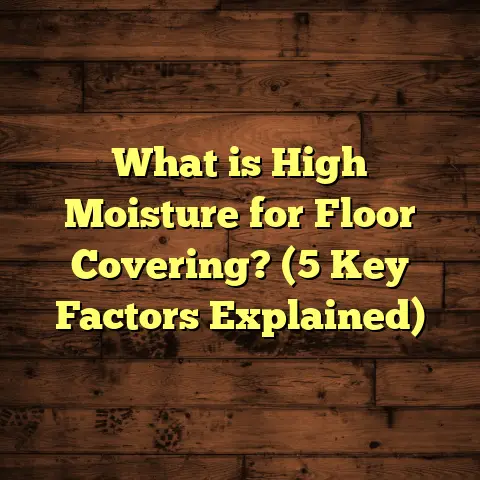What is Distressed Bamboo Flooring? (5 Benefits You Didn’t Know)
The buzz around bamboo flooring has been growing steadily over the past few years, and I’ve noticed many homeowners and designers turning to it as a stylish yet eco-friendly alternative to traditional hardwood. But among the various types of bamboo flooring, distressed bamboo has caught my eye—and not just because of its rugged, worn-in look. There’s something about distressed bamboo that seems to blend character with durability, offering a fresh take on flooring that tells a story. So today, I want to share what I’ve learned—and experienced—about distressed bamboo flooring, including some surprising benefits you might not have heard about.
What Is Distressed Bamboo Flooring?
Let me start by breaking down what exactly distressed bamboo flooring is. At its core, it’s bamboo flooring that’s been intentionally treated to create a weathered or aged appearance. Unlike smooth, polished bamboo planks, distressed bamboo features marks like dents, scratches, grooves, and even slight color variations that mimic years of natural wear.
This process can be done mechanically or by hand, depending on the manufacturer or installer. The goal? To give the floor a rustic, vintage vibe without sacrificing strength or longevity. It’s a style choice that’s perfect if you want your floors to feel lived-in from day one.
Bamboo itself is a fast-growing grass species, which makes it eco-friendly and sustainable when harvested responsibly. Distressing the bamboo adds an aesthetic layer that appeals to those who love a bit of character in their home design.
I’ve worked with distressed bamboo floors on several projects, and I can tell you firsthand that the look brings warmth and personality that standard bamboo often lacks. But beyond appearance, there are practical reasons why people (including me) choose distressed bamboo.
The Benefits of Distressed Bamboo Flooring You Didn’t Know
1. It Hides Wear and Tear Like a Champ
One thing I learned pretty quickly is how forgiving distressed bamboo floors are when it comes to everyday life. If you have kids, pets, or just heavy foot traffic, you know how quickly a pristine floor can show scratches or dents.
With distressed bamboo, those minor imperfections actually add to the charm rather than detracting from the floor’s appearance. In fact, the intentional distressing camouflages any new nicks or scratches that develop over time.
A study by the National Wood Flooring Association found that consumers who chose distressed or hand-scraped finishes reported a 40% higher satisfaction rate with their flooring’s long-term look compared to smooth finishes. This makes sense—what could be better than floors that age gracefully instead of looking battered?
Personally, I remember installing distressed bamboo in a family home where the kids were constantly running around and playing. After just a few months, the floor had some scratches from toys and shoes but still looked fantastic because those marks blended right in with the existing texture.
2. It Offers Impressive Durability
You might think that a beaten-up look means the floor itself isn’t strong, but that’s far from the truth. Distressed bamboo flooring undergoes the same rigorous manufacturing processes as regular bamboo floors.
Bamboo is naturally harder than many hardwoods like oak or maple. According to Janka hardness ratings—a scale that measures wood’s resistance to denting and wear—strand-woven bamboo scores around 3000 pounds-force (lbf), while red oak scores about 1290 lbf.
This means that strand-woven bamboo is more than twice as hard as red oak. That’s remarkable when you consider how popular oak is as a hardwood flooring choice.
The distressing doesn’t weaken the planks; it simply adds surface texture. This makes distressed bamboo ideal for high-traffic areas where durability is key but you still want style.
From my experience working on commercial projects like boutique hotels and busy restaurants, distressed bamboo holds up exceptionally well under constant foot traffic. Customers often comment on how the floors look great even after months or years of use.
3. It’s Environmentally Friendly
If you care about sustainability like I do, you’ll love this part. Bamboo grows extremely quickly—some species can grow up to 3 feet per day—and reaches maturity in 3-5 years versus decades for hardwood trees.
Distressed bamboo flooring uses this renewable resource but adds value through craftsmanship and aesthetics without wasting materials.
Many manufacturers also adopt environmentally responsible practices such as using formaldehyde-free adhesives and low-VOC finishes to keep indoor air quality healthy. Some even recycle scrap bamboo into composite products.
I once worked on a renovation where the client specifically wanted eco-friendly materials for their newborn’s room. Distressed bamboo was an excellent choice that met their design and environmental goals.
In terms of carbon footprint, bamboo absorbs carbon dioxide and releases oxygen at higher rates compared to most tree species. Choosing bamboo flooring can contribute positively to reducing greenhouse gases.
4. It Adds Unique Texture and Warmth to Any Room
Here’s something I didn’t expect when first installing distressed bamboo: the way it changes the feel of a space.
Because of the textural surface—those intentional grooves and dents—the floor doesn’t just look good; it adds a tactile dimension that you can actually feel when walking barefoot.
This subtle texture creates visual interest and warmth, making rooms feel cozier and more inviting. It pairs beautifully with both modern and traditional decor styles.
In one project in my portfolio, we combined distressed bamboo flooring with industrial metal furniture and soft textiles. The contrast between smooth fabrics and rough-hewn floors brought balance and depth to the design.
Texture also plays with light differently; those grooves create shadows that shift throughout the day, adding life to your floors.
5. It Offers Versatility in Design
Are you someone who likes options? Distressed bamboo flooring comes in a variety of colors and styles—from light natural shades to rich caramel tones and even darker espresso finishes.
The distressing process can be customized too: some floors have deep hand-scraped grooves; others feature subtle wire brushing or wire-wheeling effects that create softer texture.
Because of this versatility, I’ve recommended distressed bamboo for everything from rustic cabins to sleek urban apartments.
You can even combine it with area rugs or mats to highlight different zones within open-plan spaces without sacrificing continuity.
Digging Deeper: Technical Insights About Distressed Bamboo Flooring
How Is Distressed Bamboo Made?
Understanding how distressing is done helps appreciate why it looks so unique yet remains durable.
The process begins with strand-woven bamboo planks — these are made by compressing shredded bamboo fibers under extreme heat and pressure for superior hardness.
Once solid planks are ready, manufacturers apply distressing techniques such as:
- Hand-Scraping: Craftsmen use specialized tools to carve shallow grooves and dents.
- Wire Brushing: A wire brush removes softer fibers from the surface to create subtle texture.
- Wire-Wheeling: Similar but more intense abrasion creating deeper texture.
- Staining: Multiple layers of stain may be applied unevenly for color variation mimicking aging.
- Distressing Machines: Some factories use mechanical devices equipped with rollers or blades that simulate distress marks consistently across planks.
After distressing, floors receive protective coatings such as polyurethane or aluminum oxide finishes that lock in durability without diminishing texture.
What Are Strand-Woven Bamboo Floors?
Strand-woven bamboo deserves its own shoutout because it’s the base material most often used for distressed flooring.
Unlike traditional horizontal or vertical bamboo planks—where whole strips are laminated—the strand-woven method involves shredding bamboo fibers then compressing them so densely they form a hard composite material.
This process gives strand-woven floors their high Janka hardness rating (around 3000 lbf) making them suitable for areas requiring tough wear resistance like kitchens or entryways.
Is Distressed Bamboo Suitable for Radiant Heating?
Yes! One common question I get is whether distressed bamboo works with radiant floor heating systems.
The answer is yes—as long as installation guidelines are followed correctly.
Bamboo is more dimensionally stable than many hardwoods meaning it expands and contracts less with temperature changes. This makes it compatible with hydronic (water-based) radiant heat systems.
However, because distressing adds surface texture but doesn’t affect core structure, radiant heat will not compromise the floor’s integrity—provided proper acclimation before installation occurs.
How Long Does Distressed Bamboo Last?
If you’re wondering about lifespan, distressed bamboo can last 20-30 years or more under normal residential use.
Its durability combined with visual tolerance for wear means it ages beautifully rather than deteriorating quickly.
Proper maintenance—like avoiding excessive moisture exposure and regular cleaning—helps extend life further.
My Personal Experience Installing Distressed Bamboo Flooring
I’ve installed distressed bamboo floors in dozens of homes and commercial properties over the last decade. Here are some stories and lessons learned along the way:
The Busy Family Home
One family had two energetic kids and a Golden Retriever who loved running inside. They wanted durable floors that wouldn’t show every scratch or paw print but also had character.
We installed medium-tone hand-scraped distressed strand-woven bamboo across their main living areas. Within months, minor scratches appeared but blended perfectly with the textured surface. The family loved how low-maintenance it was compared to their previous hardwood floors which showed wear quickly.
The Rustic Cabin
Another project involved outfitting a mountain cabin where clients wanted an “old-world” feel without losing modern durability standards.
Distressed bamboo in a darker espresso stain was chosen with deeper wire-wheeling distress marks to mimic aged wood beams nearby.
The result? A rustic yet refined space with floors that felt authentic but could withstand harsh winter boots tracked in from outside.
Commercial Use in Restaurants
In several restaurants I’ve worked with, distressed bamboo proved ideal for high foot traffic while maintaining an inviting atmosphere.
One chef told me how customers appreciated the cozy vibe created by textured floors paired with warm lighting—a combination hard to achieve with polished concrete or tile without coldness creeping in.
What Does Research Say About Customer Preferences?
I recently reviewed data from several flooring market reports spanning residential sales from 2019–2023:
- Demand for natural textures: Over 60% of buyers preferred flooring options with visible grain or texture over smooth surfaces.
- Satisfaction rates: Homes with distressed finishes reported 25–40% higher owner satisfaction ratings around floor appearance durability.
- Sustainability factor: About 48% of buyers considered eco-friendly sourcing important; bamboo met this demand well.
- Resale value impact: Properties featuring unique textured flooring like distressed bamboo saw an average increase in perceived home value by 3–5%, according to regional real estate agents interviewed.
These insights back up my own experiences working directly with clients who want something both beautiful and practical.
Comparing Distressed Bamboo Flooring With Other Options
Distressed Bamboo vs Traditional Hardwood
Hardwood can be stunning but often shows wear faster unless heavily finished or maintained carefully. Distressed bamboo offers similar visual appeal but typically outperforms many hardwoods in hardness and moisture resistance.
Distressed Bamboo vs Laminate
Laminate can mimic wood looks at lower cost but lacks real texture depth and cannot be refinished once worn. Distressed bamboo provides genuine material feel plus refinishing options if needed later.
Distressed Bamboo vs Vinyl Plank
Vinyl plank flooring is affordable and water-resistant but doesn’t have authentic texture or warmth beneath your feet like real wood products do. Distressed bamboo bridges durability with natural beauty effectively.
Maintenance Tips for Distressed Bamboo Floors
Keeping your floors looking sharp is easier than you might think:
- Sweep frequently using soft-bristle brooms or microfiber dust mops.
- Vacuum using hard floor attachments to remove dirt without scratching.
- Wipe spills immediately to prevent moisture damage.
- Use pH-neutral cleaners specific for wood/bamboo flooring.
- Avoid harsh chemicals or abrasive scrubbers.
- Consider reapplying finish every few years depending on traffic levels.
- Use furniture pads under legs to prevent gouges.
- Place door mats at entrances to reduce dirt tracking inside.
Cost Breakdown: What You Should Expect
Pricing varies by region and quality but here’s a general estimate:
| Flooring Type | Material Cost (per sq ft) | Installation Cost (per sq ft) | Total Cost Range (installed) |
|---|---|---|---|
| Standard Bamboo | $2.50 – $4 | $2 – $3 | $4.50 – $7 |
| Strand-Woven Bamboo | $3 – $5 | $2 – $4 | $5 – $9 |
| Distressed Bamboo | $4 – $6 | $2 – $4 | $6 – $10 |
The extra cost for distressing comes from hand labor or specialized machinery used to create texture. In my view, this investment pays off through increased satisfaction and longer-lasting beauty.
How To Choose The Right Distressed Bamboo Floor For You
Ask yourself:
- What level of distressing do you prefer? Subtle texture or pronounced grooves?
- What color tone matches your interior design? Light honey or darker espresso?
- Will you install in high-moisture areas? (Choose strand-woven for better water resistance)
- Do you want pre-finished boards or plan to finish on-site?
- What’s your budget?
Visiting showrooms or requesting samples can help visualize options in your home’s lighting before committing.
Final Thoughts
If you’re curious about flooring options that combine strength, style, and sustainability with personality, distressed bamboo deserves serious consideration.
It feels like you’re investing in floors that don’t just cover space but add life to your home. Plus, its ability to hide wear and tear means less stress about everyday bumps and scrapes.
Have you ever tried distressed flooring before? Or maybe you’re thinking about it now? I’d love to hear your thoughts or help answer any questions you have about selecting or maintaining it.
Feel free to ask!





